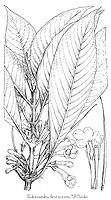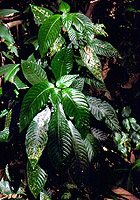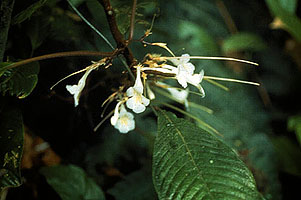
C.B. Clarke, in A. & C. DC, Monogr. phan. 5/1, t. 7 (1883)
Full name and orig. publication: Didissandra C.B.Clarke, in A.& C.DC., Monogr. phan. 5/1: 65 (July 1883) - nom. cons. p.p.
Etymology: Apparently from the Greek δι, di, δις, dis = two-, double, and ̣άνδρος, andros = man, male (male parts of the flower, androecium), referring to the presence of four stamens.
Synonym: Ellobum Blume (1826), nom. rejic.
Infrafamilial position: Didymocarpoid Gesneriaceae - "Advanced Asiatic and Malesian genera" (Weber 2004).
Description: Perennial, lignescent herbs. Stem caulescent, erect, decumbent-ascending or creeping, slightly to prominently woody. Leaves decussate or ternate, ± isophyllous, petiolate, lamina ovate, with acute or obtuse apex, usually hairy on both sides. Cymes pedunculate, unilateral (pair-flowered cincinni) (sect. Didissandra) or epedunculate, condensed few-flowered, bilateral cymes (pair-flowered dichasia) (sect. Cyrtandroides). Sepals free to base, narrow triangular, persistent. Corolla white, eventually with a violet or purplish tinge, mostly two yellow bars at tube entrance, tube cylindrical, limb bilabiate, in the spp. of sect. Didissandra the lower lip distinctly elongated. Stamens 4 or 2, didynamous, in D. anisanthera B.L.Burtt the posterior pair distinctly smaller. Nectary cup-shaped. Fruit a slender, cylindrical, ribbed capsule, dehiscing at first by two loculicidal slits, then shredding into several lamellae associated with the vascular bundles which develop conspicuous sclerenchymatous sheaths on the outer side.
Chromosome number: 2n = 20 [D. frutescens (Jack) C.B.Clarke].
Species number: 8.
Species names (incl. publication and synonyms): See Skog, L.E. & J.K. Boggan. 2005: World checklist of Gesneriaceae: http://persoon.si.edu/Gesneriaceae/Checklist.
Type species: Didissandra elongata C.B.Clarke
Distribution: W Malesia (Sumatra, Malay Peninsula, Borneo, Java).
Ecology: In lowland and montane rain forests.
Notes: Until recently, Didissandra was a taxonomical wastebasket, to which more than 80 species have been ascribed in the course of time. Examination by Weber & Burtt (1998) resulted in a split into three genera: Didissandra s.str., Ridleyandra, and Raphiocarpus. The current generic position of all species formerly associated with Didissandra can be found in Vitek & al. (1998).
Didissandra can be divided into two sections (Weber & Burtt 1998):
(1) sect. Didissandra: small, tubular flowers, suberect-ascending to creeping habit; 6 spp.; Sumatra, Borneo, Java,
(2) sect. Cyrtandroides C.B.Clarke: large, infundibuliform flowers, erect or trailing habit; 2 spp., Malay Peninsula, Borneo.
Selected references: Weber & Burtt, Beitr. Biol. Pflanzen 70 ("1997"): 153-177, 191-223 (1998), emend. & rev.; Vitek & al., Beitr. Biol. Pflanzen 70: 275-291 (1998, "1997"), checklist; Wang et al. in Wu & Raven (eds.), Fl. China 18: 281-282 (1998) (Chinese spp. of Didissandra in the former sense).
Bibliography: See Skog, L.E. & J.K. Boggan. 2005. Bibliography of the Gesneriaceae. 2nd edition: http://persoon.si.edu/Gesneriaceae/Bibliography.
Illustrations:
 |
Didissandra frutescens
(Jack) C.B.Clarke
C.B. Clarke, in A. & C. DC, Monogr. phan. 5/1, t. 7 (1883) |
 |
Didissandra frutescens
(Jack) C.B.Clarke, sterile specimens
Penins. Malaysia, Perak, foot of Maxwell's Hill, phot. A. Weber (1995) |
 |
Didissandra frutescens
(Jack) C.B.Clarke
Penins. Malaysia, Perak, phot. Leong Tuck-Lock |
last modified: 2007-07-13